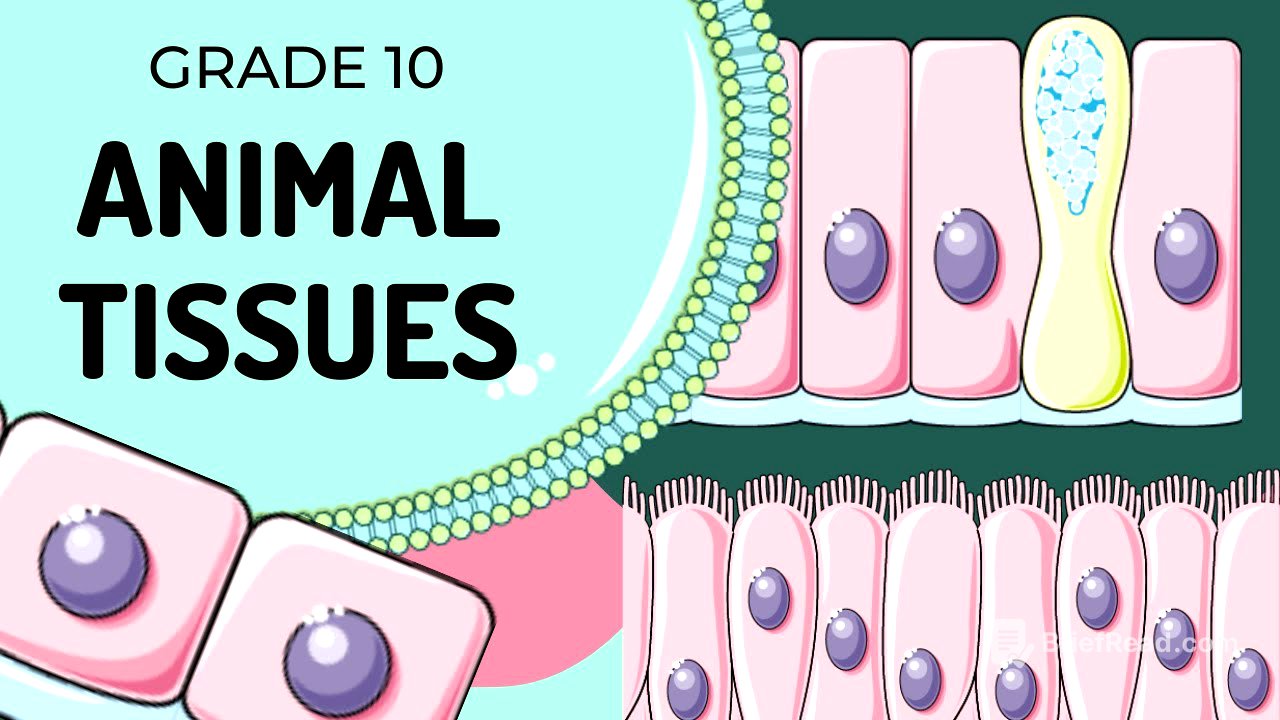TLDR;
This video provides an overview of the four main types of animal tissues: epithelial, connective, muscle, and nervous tissue. It explains the structure, function, and location of various subtypes within each tissue category. Key points include:
- Epithelial tissue protects and lines body surfaces, with squamous, columnar, and cuboidal shapes.
- Nervous tissue transmits electrochemical signals via sensory, motor, and relay neurons.
- Connective tissue supports and stabilises organs, including areolar, fibrous, cartilage, blood, adipose, and bone.
- Muscle tissue enables movement through skeletal, smooth, and cardiac muscle types.
Introduction to Animal Tissues [0:01]
The video introduces the four main types of animal tissues: connective, epithelial, muscle, and nervous tissue. Each tissue type has a specific function linked to its shape. The video will cover the specifics of each tissue, including their appearance and how to identify them in micrograph pictures. It also aims to explain how these tissues are presented in tests or exams.
Epithelial Tissue: Structure and Function [0:38]
Epithelial tissue, one of the simplest tissues, is often a single layer of cells but can also be multi-layered (stratified). These cells form a protective layer held together by a basement membrane, a thin membrane that acts like a sticky surface. Epithelial tissue has very few intercellular spaces because its function is to protect and line internal and external body surfaces, preventing openings into the body. A thin layer of connective tissue sits under the basement membrane to connect the epithelial tissue to underlying tissues like fat or muscle. The shape of the nucleus (circular or elongated) and the overall geometric shape (square or rectangular) are defining features of epithelial tissues.
Squamous, Columnar, and Cuboidal Epithelium [3:08]
The video describes the three most basic shapes of epithelial tissue: squamous, columnar, and cuboidal. Squamous epithelium consists of thin, irregularly shaped, flattened cells with a squashed nucleus. It's found in the lining of the mouth, alveoli, and skin surface, renewing itself quickly for protection. Columnar epithelium features elongated, rectangular cells with oval-shaped nuclei, sometimes ciliated with hair-like structures to increase surface area for absorption and mucus secretion. These are found in the intestines and gall bladder, aiding in digestion and absorption. Cuboidal cells are square-shaped with very spherical nuclei, often lining tubes and functioning in absorption and secretion, such as in sweat glands, the thyroid gland, and kidney tubules.
Nervous Tissue and Neuron Types [7:58]
Nervous tissue conducts electrochemical signals between organs and the brain, acting as message pathways. There are three types of nervous tissue cells: sensory neurons, motor neurons, and relay neurons (interneurons). All nerve cells have dendrites, a cell body, an axon, and axon terminals. Sensory neurons sense information, with the cell body sitting off to the side; impulses enter through dendrites, pass the cell body, and move through the axon to the axon terminals. Motor neurons control movement, with the cell body in the centre of the dendrites; messages come from the dendrites and go down the axon terminal. Relay neurons (interneurons) relay information between sensory and motor neurons, found mostly in the spinal cord and brain, with the cell body in the centre of the nerve cell. The key difference between these neurons is the location of the cell body.
Connective Tissues: Types and Functions [13:58]
Connective tissues support, stabilise, and protect the body's organs. They consist of cells surrounded by a fluid or matrix, which can be liquid, semi-liquid, or solid. The six major types of connective tissues are areolar, fibrous, cartilage, blood, adipose, and bone. Areolar tissue binds epithelium, sitting below it and attaching epithelial cells to other tissues. It consists of cells suspended in a matrix of collagen and elastin fibres, found between organs and under the skin. Fibrous connective tissue is a dense network of non-elastic collagen, providing strength and flexibility, found in tendons and ligaments. Cartilage prevents friction, with cells (chondrocytes) in a semi-fluid matrix, found between bones and at joints.
Blood, Adipose, and Bone Tissue [18:35]
Blood is the only liquid connective tissue, comprising lymphocytes (white blood cells for immunity), erythrocytes (red blood cells for gas transport), and platelets (for blood clotting). It transports waste, nutrients, and hormones within the circulatory system. Adipose tissue, made of fat cells, stores excess energy and provides insulation, found around organs and under the skin. Bone tissue provides the framework for the body, made up of systems with osteocytes secreting a solid matrix, found in the skeletal system.
Muscle Tissue: Skeletal, Smooth, and Cardiac [21:53]
Muscle tissue falls into three categories: skeletal, smooth, and cardiac. Skeletal muscle features striations (stripes) and multiple nuclei, enabling voluntary movement and attaching to bones. Smooth muscle lacks striations, consisting of spindle-shaped fibres for involuntary movement, found in the digestive system and blood vessels. Cardiac muscle, found only in the heart, is a network of branched muscle fibres with fainter striations, responsible for involuntary movement and capable of moving on its own without brain instructions.
Summary of Key Terminology [26:11]
The video summarises the key terminology covered, including the four tissue types (epithelial, nerve, connective, and muscle) and their functions. It recaps the characteristics of squamous, columnar, and cuboidal epithelium; sensory, motor, and interneurons; areolar, fibrous, blood, bone, and adipose connective tissues; and skeletal, smooth, and cardiac muscle tissues.









